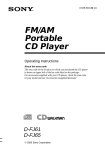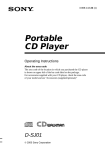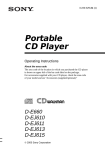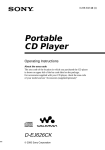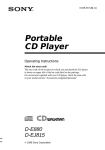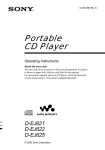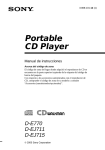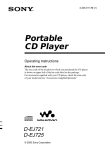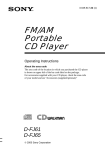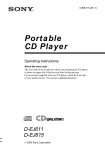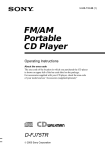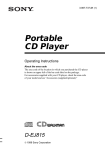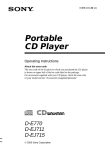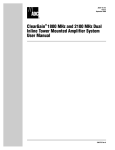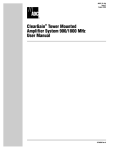Download Sony D-MJ95 User's Manual
Transcript
3-047-253-21 (1) Portable CD Player Operating Instructions About the area code The area code of the location in which you purchased the CD player is shown on upper left of the bar code label on the package. For accessories supplied with your CD player, check the area code of your model and see “Accessories (supplied/optional).” D-MJ95 2000 Sony Corporation WARNING To prevent fire or shock hazard, do not expose the unit to rain or moisture. To avoid electrical shock, do not open the cabinet. Refer servicing to qualified personnel only. CAUTION The use of optical instruments with this product will increase eye hazard. Owner’s Record The model and the serial numbers are located at the rear. Record the serial number in the space provided below. Refer to these numbers whenever you call upon your Sony dealer regarding this product. Model No. D-MJ95 Serial No. ___________________ Certain countries may regulate disposal of the battery used to power this product. Please consult with your local authority. For the customers in the USA and Canada This mark is available in the USA and Canada only RECYCLING NICKEL-CADMIUM BATTERIES Nickel-Cadmium batteries are recyclable. You can help preserve our environment by returning your unwanted batteries to your nearest point for collection, recycling or proper disposal. Note: In some areas the disposal of nickel-cadmium batteries in household or business trash may be prohibited. RBRC (Rechargeable Battery Recycling Corporation) advises you about spent battery collection by the following phone number. Call toll free number: 1-800-822-8837 (United States and Canada only) Caution: Do not handle damaged or leaking nickelcadmium batteries. 2 INFORMATION Listening for many hours at maximum volume may damage your hearing. For the customers in the USA This equipment has been tested and found to comply with the limits for a Class B digital device, pursuant to Part 15 of the FCC Rules. These limits are designed to provide reasonable protection against harmful interference in a residential installation. This equipment generates, uses, and can radiate radio frequency energy and, if not installed and used in accordance with the instructions, may cause harmful interference to radio communications. However, there is no guarantee that interference will not occur in a particular installation. If this equipment does cause harmful interference to radio or television reception, which can be determined by turning the equipment off and on, the user is encouraged to try to correct the interference by one or more of the following measures: – Reorient or relocate the receiving antenna. – Increase the separation between the equipment and receiver. – Connect the equipment into an outlet on a circuit different from that to which the receiver is connected. – Consult the dealer or an experienced radio/TV technician for help. You are cautioned that any changes or modifications not expressly approved in this manual could void your authority to operate this equipment. For the customers in Australia The supply cord of the AC power adaptor cannot be replaced; if the cord is damaged, the AC power adaptor should be discarded. Table of Contents Getting started Locating the Controls .................................. 4 Playing a CD 1. Connect your CD player. ......................... 6 2. Insert a CD. ............................................. 6 3. Play a CD. ............................................... 6 Playback options Playing tracks repeatedly (Repeat play) .... 10 Playing a single track (Single play) ........... 10 Playing tracks in random order (Shuffle play) ......................................... 10 Playing tracks in your favorite order (PGM play) ............................................ 11 Available features G-PROTECTION function ........................ 12 Emphasizing the bass sound (SOUND) .... 12 Protecting your hearing (AVLS) ................ 13 Locking the controls (HOLD) ................... 13 Turning off the operation beep sound ........ 14 Installing in a car Where to place your CD player and rotary commander ............................................ 16 Mounting your CD player ......................... 16 Replacing the fuse of the car battery cord . 17 Mounting the rotary commander ............... 18 Connecting a power source Using the AC power adaptor ..................... 20 Using the rechargeable batteries ................ 20 Using dry batteries ..................................... 22 Notes on the power source ........................ 23 Additional information Precautions ................................................ 24 Maintenance .............................................. 24 Troubleshooting ......................................... 25 Specifications ............................................ 26 Accessories (supplied/optional) ................ 27 Connecting your CD player Connecting a stereo system ....................... 15 3 Getting started Locating the Controls For details, see pages in parentheses. CD player (front) 1 Display (pages 7, 10 - 13) 2 PLAY MODE button (pages 9 - 11) 3 ./> (AMS/search) buttons (pages 7, 10, 11) 7 u (play/pause) button (pages 6, 7, 11) 8 DC IN 4.5 V (external power input) jack (pages 6, 20, 21) 9 Strap holes q; x (stop)/CHG (charge) button (pages 7, 14, 21) qa SOUND button (page 12) 4 LINE OUT jack (pages 6, 15) qs REPEAT/ENTER button (pages 9 - 11) 5 HOLD switch (page 13) qd i/REMOTE jack (page 6) 6 VOLUME +/– buttons qf OPEN switch (page 6) CD player (inside) qg G-PROTECTION switch (page 12) 4 CD player (rear) qh AVLS switch (page 13) qj Battery compartment (page 20) Rotary commander Getting started ql x (stop) button (pages 7) qk . (AMS/search)• N (play) /> (AMS/ search) control (pages 7, 10, 11) Note The supplied rotary commander should be used with this player only. 5 Playing a CD You can also use rechargeable batteries, dry batteries and house current (AC power adaptor) as a power source. Car cassette deck 1. Connect your CD player. 1 Connect the car connecting pack. 2 Connect the car battery cord. 3 Connect the rotary commander. Note Turn down the volume of the car cassette deck before inserting the car connecting pack. to a cigarette lighter socket Rotary commander Car connecting pack Car battery cord i/REMOTE 2. Insert a CD. 1 Slide OPEN and raise the lid. to DC IN 4.5 V OPEN switch 2 Place the CD on the tray and close the lid. Label side up 6 to LINE OUT 3. Play a CD. Press u. Rotate the control toward N. Adjust the volume on the car cassette deck. Press u x/CHG*2 .once quickly*2 .repeatedly*2 > once quickly*2 > repeatedly*2 Hold down .*2 Hold down >*2 Playing a CD To Play/Pause Stop Find the beginning of the current track (AMS*1) Find the beginning of the previous tracks (AMS) Find the beginning of the next track (AMS) Find the beginning of the succeeding tracks (AMS) Go backwards quickly Go forward quickly *1 Automatic Music Sensor *2 These operations can be done during both play and pause. About the display • When you press u after changing the CD or turning off and on the player, the total number of tracks in the CD and total playing time appear for about two seconds. • During play, the track number and the elapsed playing time of the current track appear. • Between tracks, the time to the beginning of the next track appears with the “-” indication. • During pause, the elapsed playing time flashes. Illumination of the display and the buttons on the CD player When using the CD player on the AC power adaptor or car battery, the display and the buttons are illuminated during play so that you can check the display and the location of the buttons easily. When charging the rechargeable batteries on this player, however, the display will not be illuminated. Notes • If the illumination of the display does not go off after you turn off the ignition key, disconnect the car battery cord from the cigarette lighter socket. • When using the CD player on the AC power adaptor, illumination of the display and the buttons may become dim during AMS operation, etc., but this is not a malfunction. (Continued) 7 If the volume level does not increase Is AVLS set to “LIMIT”? Set AVLS to “NORM.” For details, see “Protecting your hearing (AVLS).” Playback starts from the point you stopped Your CD player can recall the playback point where you stopped and then resume playing from the same place (resume function). There is no ON/OFF switch of the resume function on this CD player. Removing the CD Remove the CD while pressing the pivot in the center of the tray. 8 Playback options You can enjoy various ways of playback using PLAY MODE and REPEAT/ENTER. PLAY MODE button Each time you press the button, you can change the playback mode. “No indication” (Normal play) REPEAT/ENTER button “SHUF” (Play tracks in random order) “PGM” (Play tracks in your favorite order) REPEAT You can repeat play that is selected using PLAY MODE. ENTER You can select tracks for PGM play mode. u button ./> buttons x/CHG button 9 Playback options “1” (Play a single track) Playing tracks repeatedly (Repeat play) You can play tracks repeatedly in normal, single, shuffle and PGM play modes. During playback, press REPEAT/ENTER. Note on ./> During Repeat play, you can locate the first track after the last track by pressing > repeatedly. You can also locate the last track after first track by pressing . repeatedly. Playing a single track (Single play) During playback, press PLAY MODE repeatedly until “1” appears. Playing tracks in random order During playback, press PLAY MODE repeatedly until “SHUF” appears. 10 (Shuffle play) Playing tracks in your favorite order (PGM play) You can program the CD player to play up to 64 tracks in your favorite order. 1 During playback, press PLAY MODE repeatedly until “PGM” appears. 2 Press . or > to select a track. Playback options Playing order Track number 3 Press REPEAT/ENTER to enter the selected track. “00” appears and the playing order increases by one. 4 5 Repeat steps 2 and 3 to select the tracks in your favorite order. Press u to start the PGM play. To check the program During programming: Press REPEAT/ENTER repeatedly before step 5. During the PGM play: Press PLAY MODE repeatedly until “PGM” flashes, then press REPEAT/ENTER. Each time you press REPEAT/ENTER, the track number appears. Notes • When you finish entering the 64th track in step 3, the first selected track appears in the display. • If you select more than 64 tracks, the first selected tracks are erased. 11 B Available features G-PROTECTION function Emphasizing the bass sound (SOUND) The G-PROTECTION function has been developed to provide excellent protection against sound skipping while jogging. This function provides a higher level of shock protection than the traditional one. While jogging, be sure to hold your CD player with the OPEN switch facing upward. You can emphasize the bass-boosted sound. Press SOUND to select “BASS “BASS .” ” or “No indication” (Normal play) Set G-PROTECTION (under the lid) to “ON.” BASS BASS To turn off the G-PROTECTION function Set G-PROTECTION to “OFF.” The selected sound mode is displayed. Note Sound may skip if: – the CD player receives stronger continuous shock than expected or – a dirty or scratched CD is played. “BASS ” enhances the bass sound more than “BASS .” Note If the sound is distorted when using the SOUND function, turn down the volume. 12 Protecting your hearing Locking the controls (AVLS) (HOLD) The AVLS (Automatic Volume Limiter System) function keeps down the maximum volume to protect your hearing. You can lock the controls on your CD player to prevent accidental button presses. Set AVLS (in the battery compartment) to “LIMIT.” To turn off the AVLS function Set AVLS to “NORM.” Displayed when the HOLD function is working. You can use the HOLD function on the CD player. Even if the controls are locked on the CD player, you can still operate your CD player using the rotary commander. To unlock the controls Slide HOLD in the opposite direction of the arrow. 13 Available features Flashes when the volume is turned up and beyond a certain level. Slide HOLD in the direction of the arrow. Turning off the operation beep sound You can turn off the beep sound that is heard from your headphones/earphones when you operate your CD player. 1 Remove the power source (AC power adaptor, rechargeable batteries or dry batteries) from the CD player. 2 Connect the power source while pressing x/CHG on the CD player. To turn on the beep sound Remove the power source and then connect the power source without pressing x/CHG. 14 B Connecting your CD player Connecting a stereo system You can listen to CDs through a stereo system and record CDs on a cassette tape. For details, see the instruction manual that comes with the connected device. Be sure to turn off all connected devices before making connections. to LINE OUT Notes • Before you play a CD, turn down the volume of the connected device to avoid damaging the connected speakers. • Use the AC power adaptor for recording. If you use the rechargeable batteries or dry batteries as a power source, batteries may become completely depleted during recording. • Adjust the volume properly on the connected device so that the sound will not be distorted. When using the connecting cord • You cannot adjust the volume of the headphones/earphones. • If the sound is distorted, connect the device to the i/REMOTE jack. • The SOUND function does not work. Connecting your CD player Connecting cord Left (white) Right (red) Stereo system, cassette recorder, radio cassette recorder, etc. 15 B Installing in a car Where to place your CD player and rotary commander • Install the CD player and the supplied rotary commander in a flat location which: – does not interfere with your driving. – is not dangerous for passengers. – does not interfere with the glove box lid or ashtray. – is stable, and where nothing around it may interfere with installation. • Do not install the CD player and rotary commander near heat sources or where subject to direct sunlight, excessive dust, or moisture (especially on a dashboard). Notes • Do not affix Velcro tapes to the name plate or the lid of the battery compartment. • When you are going to park your car for a long period of time, remove the CD player from the Velcro tapes so that it will not be exposed to direct sunlight. To route the cord Use the supplied spiral tube to route the cords so that they do not interfere with your driving. Please understand that we will not incur any obligations for troubles caused by incorrect installation. If you have any questions or problems concerning your CD player, please contact your nearest Sony dealer. Mounting your CD player Attach the CD player to the console box with the supplied Velcro tapes. Bottom of the CD player Console box 16 Note on the car battery cord The 4.5V DC plug supplied with car battery cord conforms to the proposed standards of the Electronic Industries Association of Japan (EIAJ). Do not connect it to other players. Polarity of the plug (EIAJ standards) Replacing the fuse of the car battery cord If the player does not operate, check the fuse. If it is blown, replace it as follows: 1 Turn off the CD player and remove the cigarette lighter plug from the cigarette lighter socket. 2 Remove the plug end by turning it counterclockwise. 3 Remove the defective fuse from the plug. 4 5 Insert a new fuse into the plug. Notes on the car connecting pack • If no sound is heard or the car connecting pack is ejected, change the direction of playback on the car cassette deck. • Never insert the cord end of the car connecting pack into the cassette insertion door. Otherwise, the cord may break or the car cassette deck may be damaged. • You cannot use the car connecting pack with some car cassette deck. • The cord should be placed so that it does not hinder driving. • To disconnect the cord from the player, pull it out by grasping the plug. Never pull the plug out by the cord. • With some car cassette decks, you may hear some rattling noise from the car connecting pack. However, this is not a sign of malfunction. Replace the plug end by turning it clockwise. Remove Installing in a car Plug end Fuse Cigarette lighter plug Notes • Be sure to use a fuse of the same amperage and length as the one to be replaced. Never use a piece of wire as a substitute for the fuse. • If the fuse is blown again after replacing it, contact your nearest Sony dealer. In such a case, bring the defective fuse to the dealer with you. 17 Mounting the rotary commander 1 Attach the mounting hardware to the rotary commander by aligning the four catches on the mounting hardware to the four holes on the bottom of the commander and sliding the hardware until it locks into place. 2 Attach the rotary commander to a flat place with the double-sided adhesive tape. If you use the supplied rotary commander, you can control your CD player as you would control the headlight or the wiper switch of your car while driving. Attach the rotary commander to a flat place as illustrated below. Bottom of the mounting hardware Console box 18 To mount the rotary commander more securely using the supplied screw 1 Attach the mounting hardware to the mounting place (console box, etc.) with the double-sided adhesive tape. 2 Screw the mounting hardware on the mounting place. Screw hole 3 Attach the rotary commander to the mounting hardware. Note If you use the supplied screw, you have to drill a hole on the mounting place of your car; however, this allows you to mount the commander more securely. Installing in a car To route the cord Use the supplied cramper to route the cords so that they do not interfere with your driving. 19 B Connecting a power source You can use the following power sources: • AC power adaptor • Rechargeable batteries • LR6 (size AA) alkaline batteries For the battery life and charging time of the rechargeable batteries, see “Specifications.” Using the AC power adaptor Connect the supplied AC power adaptor to the DC IN 4.5 V jack and an AC outlet. Using the rechargeable batteries Charge the rechargeable batteries before using them for the first time. You can use only the following rechargeable batteries for your CD player. • NC-WMAA • NH-WM2AA 1 Open the battery compartment lid. to an AC outlet (rear) 2 to DC IN 4.5 V 20 Insert two rechargeable batteries by matching the 3 to the diagram in the battery compartment and close the lid. 3 Connect the AC power adaptor to the DC IN 4.5 V jack of your CD player and an AC outlet, then press x/CHG to start charging. To remove the rechargeable batteries Remove the batteries as illustrated below. x/CHG button to DC IN 4.5 V When to charge the rechargeable batteries You can check the remaining power of the batteries in the display. ○ Battery power is full. ○ ○ r r ○ AC power adaptor ○ Battery power is getting low. ○ ○ r ○ r Battery power is low. To an AC inlet r Lo batt* 4 Disconnect the AC power adaptor. Batteries are depleted. * Beep sounds. To keep the original battery capacity for a long time, charge the batteries only when they are completely depleted. Notes • The indicator sections of roughly shows the remaining battery power. One section does not always indicate one-fourth of the battery power. • Depending on operating conditions, the indicator sections of may increase or decrease. (Continued) 21 Connecting a power source The CD player charges the batteries. The “CHG” indicator turns on in the display, and the indicator sections of light up in succession. When the batteries are completely charged, the “CHG” and indicators turn off. If you press x/CHG after the charge has already been completed, the indicator flashes and “Full” appears in the display. Using the rechargeable batteries When to replace the rechargeable batteries If the battery life becomes shorter by about half, replace the batteries with new rechargeable batteries. Using dry batteries Use only the following dry battery type for your CD player: • LR6 (size AA) alkaline batteries Note Be sure to remove the AC power adaptor when using the dry batteries. Note on the rechargeable batteries If the battery is new or has not been used for a long time, it may not be charged completely until you charge and discharge it several times. 1 2 Note on carrying the rechargeable batteries Use the supplied battery carrying case to prevent unexpected heat. If the rechargeable batteries and the metallic objects are contacted, heat or fire may occur due to a short circuit. To remove the batteries Remove the batteries in the same way as rechargeable batteries. Insert two LR6 (size AA) batteries by matching the 3 to the diagram in the battery compartment. When to replace the batteries You can check the remaining power of the batteries in the display. Battery power is full. ○ r ○ ○ To attach the battery compartment lid If the battery compartment lid is detached by an accidental drop, excessive force, etc., attach it as illustrated below. Open the battery compartment lid. ○ r ○ Battery power is getting low. ○ ○ r ○ r Battery power is low. r Lo batt* Batteries are depleted. * Beep sounds. When the batteries are depleted, replace both batteries with new ones. 22 Notes on the power source Disconnect all power sources when the CD player is not used. On AC power adaptor • Use only the AC power adaptor supplied or recommended in “Accessories (supplied/ optional).” Do not use any other AC power adaptor. It may cause a malfunction. Polarity of the plug • When disconnecting the AC power adaptor from the AC outlet, grasp the adaptor itself. Do not pull it by the cord. • Do not touch the AC power adaptor with wet hands. On rechargeable batteries and dry batteries Connecting a power source • Do not charge the dry batteries. • Do not throw the batteries into fire. • Do not carry the batteries with coins or other metallic objects. It can generate heat if the positive and negative terminals of the battery are accidentally contacted by a metallic object. • Do not mix rechargeable batteries with dry batteries. • Do not mix new batteries with old ones. • Do not use different types of batteries together. • When the batteries are not to be used for a long time, remove them. • If battery leakage occurs, wipe off any deposit in the battery compartment, and install new batteries. In case the deposit adheres to you, wash it off thoroughly. 23 B Additional information On headphones/earphones Precautions On safety • Should any solid objects or liquid fall into the CD player, unplug it and have it checked by qualified personnel before operating it any further. • Do not put any foreign objects in the DC IN 4.5 V (external power input) jack. On the CD player • Keep the lens on the CD player clean and do not touch it. If you do so, the lens may be damaged and the CD player will not operate properly. • Do not put any heavy object on top of the CD player. The CD player and the CD may be damaged. • Do not leave the CD player in a location near heat sources, or in a place subject to direct sunlight, excessive dust or sand, moisture, rain, mechanical shock, unleveled surface, or in a car with its windows closed. • If the CD player causes interference to the radio or television reception, turn off the CD player or move it away from the radio or television. On handling CDs • To keep the CD clean, handle it by its edge. Do not touch the surface. • Do not stick paper or tape onto the CD. Not these ways • Do not expose the CD to direct sunlight or heat sources such as hot air ducts. Do not leave the CD in a car parked under direct sunlight. 24 Road safety Do not use headphones/earphones while driving, cycling, or operating any motorized vehicle. It may create a traffic hazard and is illegal in some areas. It can also be potentially dangerous to play your headsets at high volume while walking, especially at pedestrian crossings. You should exercise extreme caution or discontinue use in potentially hazardous situations. Preventing hearing damage Avoid using headphones/earphones at high volume. Hearing experts advise against continuous, loud and extended play. If you experience a ringing in your ears, reduce volume or discontinue use. Consideration for others Keep the volume at a moderate level. This will allow you to hear outside sounds and to be considerate to the people around you. Maintenance To clean the casing Use a soft cloth slightly moistened in water or a mild detergent solution. Do not use alcohol, benzine or thinner. Troubleshooting Should any problem persist after you have checked these symptoms, consult your nearest Sony dealer. Symptom Cause and/or corrective actions The volume does not increase even if you press the VOLUME + button repeatedly. No sound, or noise is heard. c Set the AVLS switch to “NORM.” (page 13) c The headphones/earphones are connected to the LINE OUT jack. Connect them to the i/REMOTE jack. c Connect the plugs firmly. (page 6) c Plugs are dirty. Clean the plugs with a dry soft cloth periodically. c Check that you are using alkaline batteries and not manganese batteries. (page 22) c Replace the batteries with new LR6 (size AA) alkaline batteries. (page 22) c Charge and discharge the rechargeable batteries several times. (pages 20 - 22) The playing time is too short when powered with the dry batteries. The playing time is too short when powered with the rechargeable batteries. When you press u, “Lo batt” or “00” appears in the display. The CD does not play. “HI dc In” appears in the display. The CD does not play or “no dISC” appears in the display when a CD is placed in the CD player. c The CD player is connected to an audio device. Adjust the volume using the volume control on the connected device. (page 15) c During stop, press x/CHG. (page 21) 25 Additional information “Hold” appears in the display when you press a button, and the CD does not play. Cannot adjust the volume with the VOLUME +/– buttons on the CD player. The CD player does not start charging. c The rechargeable batteries are used up completely. Charge the batteries. (pages 20 - 22) c Replace the batteries with new LR6 (size AA) alkaline batteries. (page 22) c Use only the AC power adaptor or car battery cord in “Accessories (supplied/optional).” (page 27) c Remove all power sources, then insert the batteries or connect the AC power adaptor again. (pages 20 - 22) c The CD is dirty or defective. (page 24) c Check that the CD is inserted with the label side up. (page 6) c Moisture condensation has occurred. Leave the CD player aside for several hours until the moisture evaporates. c Close the lid of the battery compartment firmly. (page 20) c Make sure the batteries are inserted correctly. (pages 20 - 22) c Connect the AC power adaptor to an AC outlet securely. (page 20) c The buttons are locked. Slide the HOLD switch back. (page 13) Specifications System Compact disc digital audio system Laser diode properties Material: GaAlAs Wavelength: λ = 780 nm Emission duration: Continuous Laser output: Less than 44.6 µW (This output is the value measured at a distance of 200 mm from the objective lens surface on the optical pick-up block with 7 mm aperture.) D-A conversion 1-bit quartz time-axis control Frequency response 20 - 20 000 Hz 307) +1 –2 dB (measured by EIAJ CP- • AC power adaptor (DC IN 4.5 V jack): U2/CA2/E92/MX2 model: 120 V, 60 Hz CED/CET/CEW/CEX/CE7/EE/EE1/E13/G5/ G6/G7/G8 model: 220 - 230 V, 50/60 Hz CEK/3CE7 model: 230 - 240 V, 50 Hz EA3 model: 110 - 240 V, 50/60 Hz AU2 model: 240 V, 50 Hz JE.W/E33 model: 100 - 240 V, 50/60 Hz HK2 model: 220 V, 50/60 Hz AR1/CN2 model: 220 V, 50 Hz • Sony DCC-E345 car battery cord for use on car battery: 4.5 V DC Battery life* (approx. hours) (When you use the CD player on a flat and stable surface.) Playing time varies depending on how the CD player is used. When using Output (at 4.5 V input level) Line output (stereo minijack) Output level 0.7 V rms at 47 kΩ Recommended load impedance over 10 kΩ Headphones (stereo minijack) Approx.5 mW + Approx. 5 mW at 16 Ω (Approx. 1 mW + Approx. 1 mW at 16 Ω)* *For the customers in France Power requirements For the area code of the model you purchased, check the upper left side of the bar code on the package. • Two Sony NC-WMAA rechargeable batteries: 2.4 V DC • Sony NH-WM2AA rechargeable batteries: 2.4 V DC • Two LR6 (size AA) batteries: 3 V DC G-PROTECTION function on off Two NC-WMAA (charged for about 3 hours**) 8 7 NH-WM2AA (charged for about 4 hours**) Two Sony alkaline batteries LR6SG 18 15 32 28 * Measured value by the standard of EIAJ (Electronic Industries Association of Japan). ** Charging time varies depending on how the rechargeable battery is used. Operating temperature 5°C - 35°C (41°F - 95°F) Dimensions (w/h/d) (excluding projecting parts and controls) Approx. 131 × 30 × 136 mm (5 1⁄4 × 1 3⁄16 × 5 3⁄8 in.) Mass (excluding accessories) Approx. 194 g (6.8 oz.) Design and specifications are subject to change without notice. 26 Accessories Optional accessories (supplied/optional) Supplied accessories For the area code of the location in which you purchased the CD player, check the upper left side of the bar code on the package. AC power adaptor (1) Headphones/earphones (1) Rotary commander (1) Rotary commander mounting kit (1) Rechargeable batteries (2) Battery carrying case (1) Car battery cord (1) Car connecting pack (1) Velcro tape (2) Spiral tube (1) AC power adaptor Active speaker system AC-E45HG SRS-T1 SRS-Z500 Car battery cord DCC-E345 Car battery cord with car connecting pack DCC-E34CP Car connecting pack CPA-9C Connecting cord RK-G129HG RK-G136HG Rechargeable battery NH-WM2AA Earphones MDR-E848LP MDR-EX70LP Headphones MDR-A44L MDR-A110LP Your dealer may not handle some of the above listed accessories. Please ask the dealer for detailed information about the accessories in your country. Additional information 27 Sony Corporation Printed in Malaysia





























